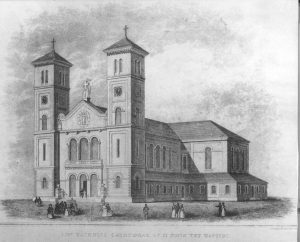ARCHIVAL MOMENT
August 15, 1864
In Newfoundland and Labrador, August 15 is better known as Lady Day. On August 15 there is a long established tradition that the “catch of fish” on this day was to be given over to the church.
‘Lady Day,’ the fifteenth of August, in some parts of the province signaled the end of the fishing season. It was not unusual for some fishermen to ‘give it up’ for the remainder of the summer.
On August 14, 1864 Bishop John Thomas Mullock, the Roman Catholic Bishop of St. John’s “called on the people of the St. John’s area to fish for St. Patrick’s Church tomorrow”. Bishop Mullock was so determined to get the fishermen up and out fishing at an early hour that he put on a special mass in the Cathedral (now the Basilica) at 4:00 a.m. “for the people going to fish…”
August 15, the Feast of the Assumption of Mary, was one of the great feast days in the calendar of the Catholic Church. So important was this day that it was considered a Holy Day of Obligation, a day to refrain from work, a day demanding that the faithful attend Mass.
“LADY DAY” IN NEWFOUNDLAND
When the Roman Catholic Cathedral (now Basilica) was being constructed Bishop Michael Anthony Fleming of Newfoundland received in 1834 from Pope Gregory XVI, the faculty to dispense the fishermen subject to his spiritual jurisdiction from the obligation of fasting on the vigils of saints. This allowed Bishop Fleming to give permission to the fishermen to fish for the church on holy days, like Lady Day. Bishop Fleming referred to himself as “the prelate of a congregation of impoverished fishermen.”
Father Kyran Walsh (the priest in charge of the construction of the R.C. Cathedral (now Basilica) would collect Lady Day fish in the summer, and so raised the thousands of pounds that were needful to complete the Cathedral.
Lady Day in many communities became a day of celebration – at the end of the “fishing day” in some communities (especially in Placentia Bay) dinner and dances were held in the parish halls.
On August 19, 1944 one writer for the Western Star newspaper in Corner Brook, lamented that:
“The 15th of August passed by rather uneventfully. However, many sadly recalled the big celebrations it occasioned in days gone by, and would like to see it return to its former festivity.”
Rooms Tour: Fishing for Cod: You could say Newfoundland and Labrador exists because of cod fish. So many cod that at one time that you could literally dip your bucket over the side of your boat and fill a pail with fish. For over 400 years the salt cod industry was the backbone of life in Newfoundland and Labrador. Generations of fishing men, women and children spent their lives “making fish.”
Come with us on a tour at The Rooms of two exhibitions, From This Place: Our Lives on Land and Sea and Here, We Made a Home, to learn about the salt cod trade in the province.


